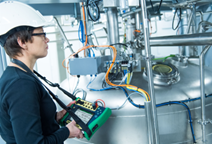
Ensuring Safety And Sustainability In The Fine Chemicals Industry

In addition to the non-negotiable, number-one priority of ensuring safety, the key factors driving the fine chemicals industry today are sustainability and efficiency. This is because of the nature of fine chemicals, which are typically produced in relatively small volumes for the manufacture of high-value end products. As a result, process errors or other disruptions that lead to batch rejection can be extremely costly.
Sustainability and efficiency are critical drivers
When it comes to efficiency, the need extends all the way to ensuring an adequate supply of raw materials and supply chain efficiency. In the plant itself, process efficiency is critical and there is a strong focus on getting things right first time, every time. There is also increasing pressure to “do more with less” in order to stay competitive.
From a sustainability perspective, fine chemicals typically require a large amount of inputs to produce a small amount of product, meaning that ensuring each batch is usable is important to minimise waste. In addition, using single-use sensors for example have an advantage over reusable sensors which need to be washed, generating wastewater that needs to be treated.
Automation is the answer
Automation offers a solution to all of these challenges. One area that is particularly ripe for automation in fine chemical production is calibration. Beamex’s automated calibration solutions combine software, hardware, and calibration expertise to deliver an automated, paperless flow of calibration data that minimises the need for manual data entry, improving operational efficiency.
This not only saves time and makes the process far more effective, but it also helps to avoid mistakes typically associated with manual data entry – thus improving the quality and integrity of the calibration data. Properly calibrated transmitters minimise waste because they help to ensure that the end product has been produced according to the specifications. Furthermore, calibration results are safely stored, tamper proof, and easily accessible in the calibration software for audit or analysis purposes.
Automated calibration is particularly well suited to the special nature of fine chemicals production environments, where for example there can be ATEX (explosive) environments or other highly sensitive areas. Ensuring that all transmitters are properly calibrated is critical for personnel and product safety.
Work with a trusted advisor
As with all digitalisation initiatives, having a trusted advisor who can help analyse the process and find areas for improvement is an absolute must to ensure that all potential benefits of a new solution are realised. In an industry like fine chemicals production with its strict compliance and safety requirements, the deep insight into the process that a partner like Beamex can bring offers distinct advantages and ensures that the automated calibration system will improve the efficiency of existing processes while ensuring compliance with industry-specific requirements.
Download our whitepaper to learn more: https://hubs.la/Q01gRMdg0
External URL: https://hubs.la/Q01gRMdg0
By Beamex
433 Views
Recent Posts
- Explore the Impact of Verifying Carbon Capture Technologies
- ITS wins Supplier of the Year at the ISPE UK Affiliate Annual Awards
- Cembre MG4 | The Newest Thermal Printer for Identification & Labelling | Available From Thorne & Derrick
- Share your expertise at ICPVT15: International Conference on Pressure Vessel Technology
- Minimising GWR Probe Build Up with the Magnetrol Eclipse 706
Back to News >



